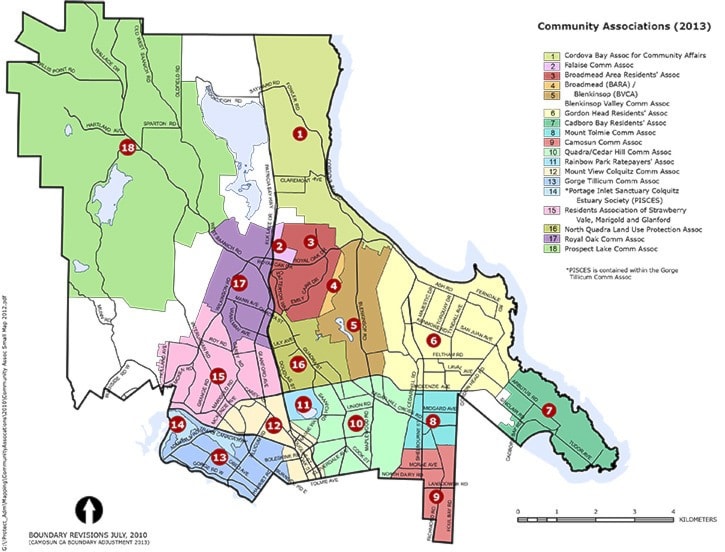If council is the brain of Saanich’s political body, its community associations might well make up its collective heart. And if you extend the metaphor, it is clear some community associations need an infusion of fresh blood.
“Make it front page, because we need volunteers,” said Illarion Gallant, vice-president of the Blenkinsop Valley Community Association, regarding Saanich Community Association Network (SCAN).
Community associations, according to Saanich’s web site, consists of Saanich residents that “provide valuable input to council and Saanich staff on items such as land use and planning proposals.”
This status makes them important transmission points between the public-at-large in each of the 18 neighbourhoods that they represent, elected officials and other actors, including private enterprise, non-for-profit agencies and other members of local civil society.
As such, community associations and their boards are democratic laboratories that also prepare their members for higher political offices. Consider current Coun. Fred Haynes, whose numerous positions on the community association level helped him prepare for his current elected position.
“Working for three years as the chair of SCAN helped build my understanding of neighbourhood and housing issues across Saanich,” he said. “Through the Peninsula Stream Society and the Prospect Lake Preservation Society I better understand the importance of our watershed and environmental stewardship issues. As a community liaison with the University of Victoria, I came to appreciate some of the local “Town and Gown” issues around student housing and university land uses.”
Involvement with Saanich’s rural agricultural community also deepened his appreciation of local food and farming issues.
“Common to all these has been the value of understanding the role of good communication processes and working collaboratively to achieve positive outcomes for the community,” he said.
To understand the influence of community associations, consider the following, non-exhaustive examples. Blenkinsop Valley Community Association, Gordon Head Residents’ Association and Cordova Bay Association for Community Affairs played formative roles in the initiation and execution of the Mount Douglas Park Access Study Report.
The Camosun Community Association, meanwhile, has been an important voice in the fate of the proposed re-development of Townley Lodge.
One measure of this influence? Last week, the proponent of the proposed re-development, the Greater Victoria Housing Society, met with the association’s board to see whether a revised proposal could eventually gain neighbourhood support.
Less than two years ago though, the Camosun Community Association also confronted questions about its long-term survival after its former president, Michael Crowe, had sent out an urgent message to the public for volunteers to fill various positions.
“It cannot be the same people all the time and I just don’t have time anymore,” Crowe said at the time.
Gallant can sympathize with this perspective. While he praises his board colleagues in the highest possible tones, he also notes that it is “same people, year after year,” who serve on the board. “It is tough to volunteer,” he said. “People have busy lives.”
Other boards face comparable struggles. The Broadmead Area Residents’ Association is looking for volunteers according to a post on its Web site, and so is the Royal Oak Community Association, based on returned responses to a series of questions SCAN forwarded to the community associations on behalf of the Saanich News.
So what accounts for some of the troubles that associations have in recruiting volunteers?
For some associations like Blenkinsop Valley Community Association, it is a question of drawing from a smaller pool of potential recruits, says Gallant, in pointing to rural nature of the association. Societal norms have also changed, he argued. Volunteerism has suffered a steady decline since the Second World War in the face of other demands and potential distractions.
This said, other community organizations offered different accounts.
Eric Dahli, president of the Cadboro Bay Residents Association, said CBRA has been fortunate to have lots of volunteers who respond when required, with the board representing a cross section of skills and abilities. They include a retired Coast Guard captain, a planner, a psychologist, a retired professor, a human resources professional, a realtor, and a retired lawyer to name a few, he said.
Barb Sharpe, spokesperson for of Royal Community Association, said retaining volunteers is easier when the group genuinely likes and respects each other in their service together. While volunteers do not receive compensation, they receive reimbursement for expenses incurred, she said. “We try to recognize, in small but tangible ways, the community service our volunteers provide,” she said.
In fact, those who step note that they find the work remarkably interesting and engaging. Gallant agrees. “It has really helped me professionally,” he said.
He has come to appreciate his fellow board members and the discussions that they have. “They are sophisticated, they are heated and they are passionate.”
He only wishes more people would join them.
wolfgang.depner@saanichnews.ca
